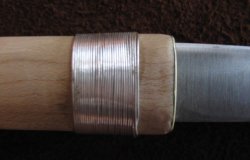A Viking Woman's Knife from Gotland

This is my interpretation of the knife of a woman of means from Gotland, Sweden, in the Viking era, the 9th-11th century. It is based as closely as possible on primary research, with compromises for materials, tools, and techniques available to me. It is not a precise reproduction of any one actual knife, but is based on my feel after looking at dozens of knives from female Viking era burials on Gotland, interpreted through my wider knowledge of medieval knives from other primary and secondary sources.
My main sources of research were 'Die Wikingerzeit Gotlands', Volumes I and II; 'Viking Knives from the Island of Gotland, Sweden'; 'The Mastermyr Find: A Viking Age Tool Chest from Gotland'; 'Knives and Scabbards: Medieval Finds from Excavations in London'; and 'Anglo-Saxon Crafts'.
'Die Wikingerzeit Gotlands' is a series of books on the archaeology of Viking Gotland; vols I and II are archival photographs of the artifacts from the grave finds there. Volume II is typological; Volume I was even more valuable, because it contains the artifacts sorted by the graves they were from. Thus I could both be sure (by the presence of female or male jewelry and other identifiers) whether a given knife was a woman's or not, and get a feel for the distribution of features of the knives - which aspects were common, which rare, which ones came in richer graves and which in poorer, etc.
'Viking Knives from the Island of Gotland, Sweden' is a CD from ArkeoDok by professor Dan Carlsson, an archaeologist working on Gotland. It contains both many pictures of knives and reconstructions, and a very informative short article by Dr Carlsson (he calls it "a short resume") about those knives.
'The Mastermyr Find' is a book on the Viking age tool chest excavated at Mastermyr, Gotland. It has both information on the tools and materials found, and analysis.
' Knives and Scabbards' is actually specifically about knives excavated from London from the 12th - 15th century, but is a great source of informationabout medieval knives, and their construction and materials, in general.
'Anglo-Saxon Crafts' is not only not about Gotland, it's not even about Viking era Swedes or other Norse. It is however a very precise book on Viking era Saxon crafts, and has been very useful in extrapolating technique used to create a piece of the period when I could not find a specific Norse technique in my research.
The knife has a blade of high carbon steel, reground from a circa 1950 butchers skinning knife. The handle is curly maple. The front plate, butt plate, suspension loop, pin and nails are brass. The wire wrap is fine silver. Hopefully invisible to the judge's eye is Devcon epoxy beneath the surface.


The soil of Gotland has preserved many buried artifacts, including Viking knives, with great care, making it possible to see a much higher level of information than is available from most similar sites. This let me attempt a fairly complex piece with a reasonably high level of confidence in my research.
The actual blades were most often a composite forged in layers, with a steel center held between iron sides, forged together into a solid but not homogenous whole. I do not have a forge, and similar laminated bladestock is available today, but both money and time kept me from obtaining a piece. The steel blade I ground is of typical dimensions for a Viking knife from Gotland, and is ground to a typical cross sectional profile.
Wooden knife handles from Viking Gotland are numerous, and some are even very well preserved, but none were succesfully analyzed as to species. Carlsson speculates that oak, juniper, birch and maple were likely. The Mastermyr book says oak is unlikely, includes several tools with ash handles but no handled knives, and contained two pieces of maple that seem to be handle blanks for future work. Knives and scabbards has box as the common handle wood, maple second, and all other woods represented by only a handful of pieces each. I did not have convenient access to ash or box, but I had maple.
If women's knives in Viking Gotland had one piece of metal used on the handle, it was a wire wrap near the front, most often of silver. The wire used was usually 0.4-0.5mm, but the only silver wire I had in sufficient quantity was 0.25mm, which I used. If such knives had more metal, it was a copper alloy (bronze or brass) suspension loop, often with a butt plate nailed on and a cross pin through the tangs of the suspension loop. Front plates are less common, but represented, and seem to make a knife seem more finished to our modern sensibilities.
I did all work on the knife myself, using a large variety of hand tools for whatever I could, and a few power tools (drill, grinders) when I could not get a satisfactory result with hand tools in the amount of time available.
References
Arwidsson, G. and Berg, B. 2000. The Mastermyr Find: A Viking Age Tool Chest from Gotland. Larson Publications.Carlsson, D. 2003. Viking Knives from the island of Gotland, Sweden (CD-ROM). Arkeodok.
Cowgill, J., Griffiths, N. and de Neergaard, M. 1987. Knives and Scabbards. Medieval Finds from Excavations in London. HMSO.
Leahy, K. 2004. Anglo-Saxon Crafts (Revealing History). Tempus Publishing.
Thunmark-Nylen, L. 1996. Die Wikingerzeit Gotlands. I. Abbildungen der Grabfunde. KVHAA.
Thunmark-Nylen, L. 1998. Die Wikingerzeit Gotlands. II. Typentafeln. Almqvist and Wiksell.